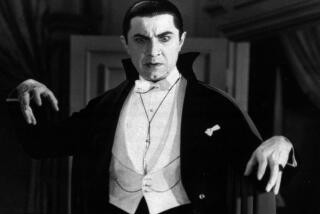Review: The fresh horror film ‘Lights Out’ feeds on audience’s fear of the dark
Exploiting our fear of the dark is a trick as old as the movies themselves, but it’s hard to recall the last picture that took the idea to such literal-minded extremes as “Lights Out.” The tale of a restless evil spirit who suffers from an extreme aversion to light, this nifty little chiller may be the first movie of its kind to unite the pleasure of a good haunting with the horror of an unpaid electricity bill.
Whenever the spirit, called Diana, finds herself in a murderous mood (which is rather often), the lights begin to flicker ominously, threatening to plunge her victims into the total darkness that is her preferred environment and hunting ground. Like a vampire exposed to sunlight, Diana can be scared off by a sudden burst of illumination — the beam of a flashlight, the glow of a neon sign or even the headlights of a parked car. It’s a ground rule that calls forth no shortage of strategic ingenuity from the director, David F. Sandberg, who turns every room into a shadow-strewn obstacle course and places his characters at the mercy of unreliable battery-powered equipment.

Teresa Palmer, Gabriel Bateman star in the trailer for the horror film “Lights Out.”
He and his cinematographer, Marc Spicer, cleverly modulate the levels of darkness in each frame, planting pools of light like small island oases in a pitch-black sea. The light is crucial, not only because it keeps some of the characters alive but because without it the viewer could not see Diana herself, a shrieking, sharp-clawed silhouette played by the actress and stunt double Alicia Vela-Bailey. We catch an early glimpse of her rising from the floor of a dimly lighted factory warehouse, where a man named Paul (Billy Burke), insufficiently grasping the rules of the movie’s premise, makes the mistake of venturing into the shadows and is promptly gutted before the opening credits.
The remainder of this admirably swift 81-minute movie — nimbly expanded by the screenwriter Eric Heisserer from Sandberg’s clever 2013 short film of the same title — follows Paul’s family members as they cope with his tragic death and try to avoid their own. His mentally unstable widow, Sophie (Maria Bello), keeps the curtains in her Los Angeles house drawn as tightly as a shroud; at night, she can be heard exchanging whispers with an unseen but not-quite-imaginary friend. Sophie’s young son, Martin (Gabriel Bateman), senses that Diana is on the prowl and reaches out to his older stepsister, Rebecca, who abruptly left home years ago after seeing their mom decline beyond recognition.
Rebecca is the movie’s central figure, and she’s played with the right tough-and-tender notes by Teresa Palmer, an Australian actress who routinely gives good performances in less-than-worthy vehicles (“The Choice,” “Kill Me Three Times”). She fares better here, despite the script’s weirdly moralizing suggestion that parental neglect will automatically turn you into a bong-smoking, commitment-phobic goth girl who lives above a tattoo parlor. It’s a reductive characterization that Palmer slips into for a few moments before deftly pushing it to the side.
“Lights Out,” a derivative but effortlessly watchable horror exercise, accomplishes something similar throughout: It tries on any number of clichés for size, throws out the ones that don’t work, and even succeeds in turning a few inside out. The Swedish-born Sandberg, an uneven but promising talent, achieves a sly balance of narrative silliness and emotional sincerity. The movie’s most preposterous element is the Sophie-Diana backstory, with its intimations of creepy medical experimentation and evil-twin psychodrama, but Sandberg dramatizes the fallout with something that might be construed, from a slightly different angle, as psychological realism.
Her dark eyes ringed with anxiety and helplessness, Bello gives a tremulous wacko-mom performance from which she has eliminated every whisper of camp. She’s both sympathetic and infuriating, and her scenes with her daughter hint at a more painful, complicated emotional history than the movie has time to explore, though it’s nice that it bothers to explore it at all. (On hand to provide some stability and a few glimmers of goofball humor is Rebecca’s dorky, dependable boyfriend, played by Alexander DiPersia.)
It’s telling that one of the movie’s producers is the prolific genre maestro James Wan, who, since making his own twisted directing debut with the original “Saw” (2004), has become a reliable studio franchise player with a certain specialty in haunted-house movies. “Lights Out” doesn’t have the shuddering virtuosity of a movie like Wan’s “The Conjuring” or the best moments of his three “Insidious” films, but it does put its own inventive spin on a tired subgenre.
Mercifully, this isn’t a movie about moving into the sort of dubious piece of real estate that might as well have a “Beware of Ghost” sign hanging out front. It’s about what happens when our most cherished and familiar spaces no longer feel safe — not just because of the evil that has moved in but also because of the good that has long since vacated the premises. Everything here, from a failing lamp on a nightstand to the terror and exhaustion in Bello’s eyes, helps throw the story’s poignant central theme into harrowing relief: the fear and threat of abandonment. No one in “Lights Out” is immune to it, Diana perhaps least of all.
------------
‘Lights Out’
MPAA rating: PG-13, for terror throughout, violence including disturbing images, some thematic material and brief drug content
Running time: 1 hour, 21 minutes
Playing: In general release
ALSO
‘Star Trek Beyond’ stars on ‘uncomfortable conversations,’ Sulu’s sexual orientation and the future
‘I was terrified’: Kristen Stewart on working with Nicholas Hoult on their new movie ‘Equals’
It’s never been easy being Jason Bourne: A brief film history
More to Read
Only good movies
Get the Indie Focus newsletter, Mark Olsen's weekly guide to the world of cinema.
You may occasionally receive promotional content from the Los Angeles Times.









